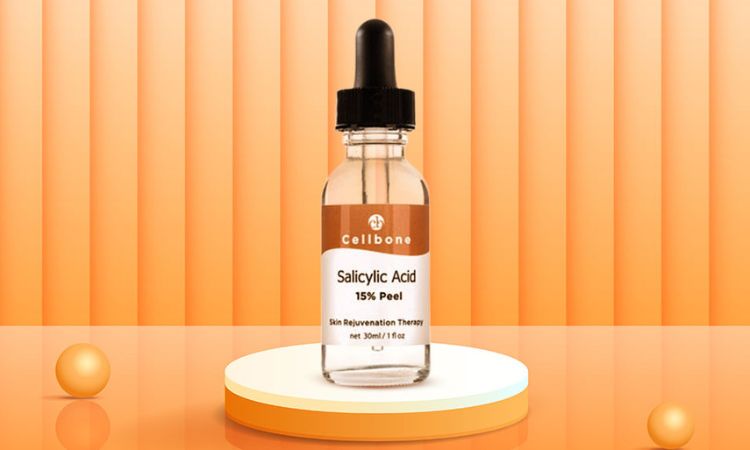It is common to see influencers posting about salicylic acid peels. Your esthetician might have brought up the idea while doing your last facial. You might be asking: Does this actually help? What should I expect? Will it leave my face with chemical burns?
If you take some time to get ready, it’s not very scary at all.
Trying something new for your skin can be a little scary at first. Particularly when you hear the terms “acid” and “peel” being used. Unlike some other chemical peels, a salicylic acid peel is actually very gentle—and it’s very helpful for acne, blackheads and oily skin.
So, if your skin has issues and nothing appears to help, this could give you real results.
Let’s get real about this: what exactly is this peel, what should you do before and after and how can you make sure things go well with it?
The Basics: What Even Is a Salicylic Acid Peel?
Think of it like a deep clean for your pores.
Salicylic acid is a beta hydroxy acid (BHA) – meaning it’s oil-soluble. Translation? It reaches your pores, clears your dead skin and any sebum and gets rid of everything causing blackheads and acne.
A salicylic acid peel fastens the cleansing of the skin by providing exfoliation in a safe manner. It often has 10% to 30% salicylic acid and can be used by a professional or applied at home with a less concentrated solution. Once applied, the acid works its magic—loosening dead skin, unclogging pores, and encouraging skin turnover.
Your pores will appear smaller, your skin will no longer look oily and its tone will level out after a few days.
Before the Peel: What You Gotta Know
Here’s where prep comes in. You don’t want to go into this blind.
1. Ease off other actives.
Stop using products with retinol, benzoyl peroxide, AHAs, or vitamin C about 3–5 days before your peel. Using them too close to your peel date can over-sensitize your skin.
2. Patch test it. Seriously.
Even if you’ve used salicylic acid before, patch test the peel product. Your skin can react differently at higher strengths.
3. Hydrate like it’s your job.
Start moisturizing more in the days leading up to your peel. Hydrated skin tolerates exfoliation better and heals faster afterward.
4. Skip the gym.
On the day of your peel and for at least 24 hours after, avoid sweating like crazy. Sweat can irritate freshly treated skin.
The Process: What Happens During the Peel
If you’re getting your peel done at a spa or derm’s office, here’s what usually goes down:
- Cleanse- Your skin is thoroughly cleansed to remove oil and grime.
- Application- The peel is swabbed onto your face. You might feel a tingling or slight burning, but it shouldn’t be painful.
Wait. The acid stays on for a few minutes—timing depends on strength and your
skin type.
- Neutralize + moisturize- The peel is either left to self-neutralize or rinsed off, followed by soothing serums or creams.
If you’re doing an at-home peel, it’s the same idea—just lower strength and shorter timing. Always follow the directions exactly. No freestyling.
Aftercare: The Most Important Part
What you do after your peel matters big time. Here’s how to avoid the dreaded “bad reaction” spiral:
1. Avoid the sun like it’s lava.
Your skin will be extra sensitive, so wear SPF 30+ every single day—even if it’s cloudy.
2. Don’t pick or peel.
Some flaking is normal. Let it happen naturally. Picking can lead to scarring or hyperpigmentation.
3. Moisturize and be gentle.
Use a basic, no-frills moisturizer. Skip actives for about a week post-peel.
4. Say no to exfoliation.
Don’t use scrubs, exfoliating toners, or anything harsh until your skin is fully healed.
You might not peel at all—or you might peel a little. Everyone’s skin reacts differently. The real glow usually kicks in after 5–7 days.
Skin Peel Serum: Is It the Same Thing?
Not exactly. A skin peel serum often contains exfoliating ingredients like salicylic acid or glycolic acid but in a lower concentration than a true peel. It’s made for regular use—think 2–3 times a week—to maintain smooth skin and prevent buildup.
A salicylic acid peel, on the other hand, is a more intense treatment. Use it occasionally (every few weeks or once a month) for a deeper reset.
That said, the two can work together in your routine—as long as you space them out.
The Results: What to Expect
After your first peel, don’t expect instant movie star skin. The results are usually gradual.
Here’s what you can expect:
- Clearer, less congested pores
- Fewer breakouts
- Smoother texture
- Less oil production
- A more even skin tone
Final Word
Peels like salicylic acid ones aren’t just for pros or beauty junkies—they’re a solid option for anyone dealing with acne, oil, or uneven skin. With a little prep, some patience, and solid aftercare, they can make a noticeable difference in your skin.
Just remember: your face isn’t the place to wing it. Read the instructions, prep right, and don’t skip the SPF.
Your glow-up? Totally worth it.
- What to Know and How to Prepare for Your First Salicylic Acid Peel
- Learn what to expect from your first salicylic acid peel, including skin benefits, preparation tips, and aftercare advice for a safe and glowing experience.
- Skincare
Related posts:
 Eye-Serum-Cream: A Beauty Secret Every Woman Deserves to Know
Eye-Serum-Cream: A Beauty Secret Every Woman Deserves to Know
 The Ultimate Guide to Buy Lipstick Online for Every Makeup Lover
The Ultimate Guide to Buy Lipstick Online for Every Makeup Lover
 Chin Fillers Treatment in Dubai: How Safe Is It? for Chin fillers
Chin Fillers Treatment in Dubai: How Safe Is It? for Chin fillers
 Unlock Your Best Look: Finding the Best Hair Stylist in Madison WI
Unlock Your Best Look: Finding the Best Hair Stylist in Madison WI
 The Vanity Unisex Salon: Redefining Hair Care as the Leading Hair Salon in Dehradun
The Vanity Unisex Salon: Redefining Hair Care as the Leading Hair Salon in Dehradun
 Does PRP Hair Treatment Improve Hairline Health? A comprehensive Guide
Does PRP Hair Treatment Improve Hairline Health? A comprehensive Guide
 Everything No One Tells You About Breast Augmentation in Dubai
Everything No One Tells You About Breast Augmentation in Dubai
 Botox Price in Pakistan vs. Results: Is It a Smart Beauty Investment?
Botox Price in Pakistan vs. Results: Is It a Smart Beauty Investment?








